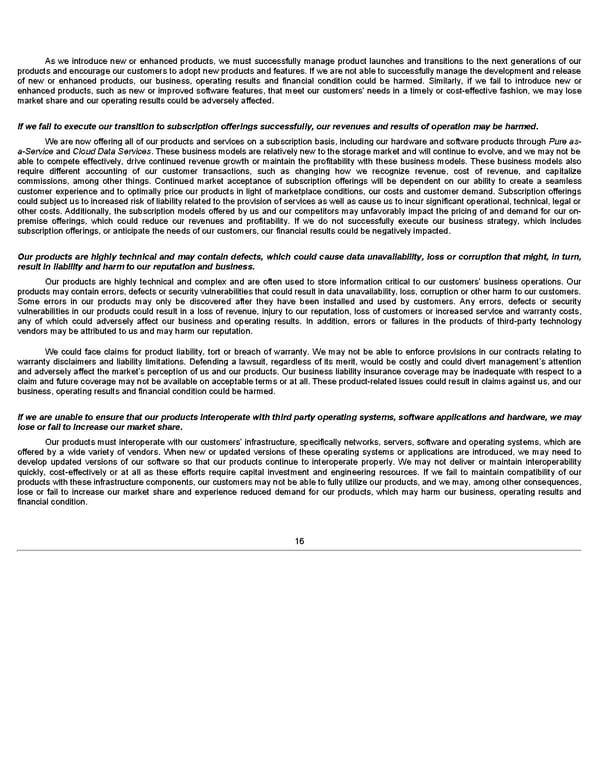As we introduce new or enhanced products, we must successfully manage product launches and transitions to the next generations of our products and encourage our customers to adopt new products and features. If we are not able to successfully manage the development and release of new or enhanced products, our business, operating results and financial condition could be harmed. Similarly, if we fail to introduce new or enhanced products, such as new or improved software features, that meet our customers' needs in a timely or cost-effective fashion, we may lose market share and our operating results could be adversely affected. If we fail to execute our transition to subscription offerings successfully, our revenues and results of operation may be harmed. We are now offering all of our products and services on a subscription basis, including our hardware and software products through Pure as- a-Service and Cloud Data Services. These business models are relatively new to the storage market and will continue to evolve, and we may not be able to compete effectively, drive continued revenue growth or maintain the profitability with these business models. These business models also require different accounting of our customer transactions, such as changing how we recognize revenue, cost of revenue, and capitalize commissions, among other things. Continued market acceptance of subscription offerings will be dependent on our ability to create a seamless customer experience and to optimally price our products in light of marketplace conditions, our costs and customer demand. Subscription offerings could subject us to increased risk of liability related to the provision of services as well as cause us to incur significant operational, technical, legal or other costs. Additionally, the subscription models offered by us and our competitors may unfavorably impact the pricing of and demand for our on- premise offerings, which could reduce our revenues and profitability. If we do not successfully execute our business strategy, which includes subscription offerings, or anticipate the needs of our customers, our financial results could be negatively impacted. Our products are highly technical and may contain defects, which could cause data unavailability, loss or corruption that might, in turn, result in liability and harm to our reputation and business. Our products are highly technical and complex and are often used to store information critical to our customers’ business operations. Our products may contain errors, defects or security vulnerabilities that could result in data unavailability, loss, corruption or other harm to our customers. Some errors in our products may only be discovered after they have been installed and used by customers. Any errors, defects or security vulnerabilities in our products could result in a loss of revenue, injury to our reputation, loss of customers or increased service and warranty costs, any of which could adversely affect our business and operating results. In addition, errors or failures in the products of third-party technology vendors may be attributed to us and may harm our reputation. We could face claims for product liability, tort or breach of warranty. We may not be able to enforce provisions in our contracts relating to warranty disclaimers and liability limitations. Defending a lawsuit, regardless of its merit, would be costly and could divert management’s attention and adversely affect the market’s perception of us and our products. Our business liability insurance coverage may be inadequate with respect to a claim and future coverage may not be available on acceptable terms or at all. These product-related issues could result in claims against us, and our business, operating results and financial condition could be harmed. If we are unable to ensure that our products interoperate with third party operating systems, software applications and hardware, we may lose or fail to increase our market share. Our products must interoperate with our customers’ infrastructure, specifically networks, servers, software and operating systems, which are offered by a wide variety of vendors. When new or updated versions of these operating systems or applications are introduced, we may need to develop updated versions of our software so that our products continue to interoperate properly. We may not deliver or maintain interoperability quickly, cost-effectively or at all as these efforts require capital investment and engineering resources. If we fail to maintain compatibility of our products with these infrastructure components, our customers may not be able to fully utilize our products, and we may, among other consequences, lose or fail to increase our market share and experience reduced demand for our products, which may harm our business, operating results and financial condition. 16
 Annua lReport Page 15 Page 17
Annua lReport Page 15 Page 17